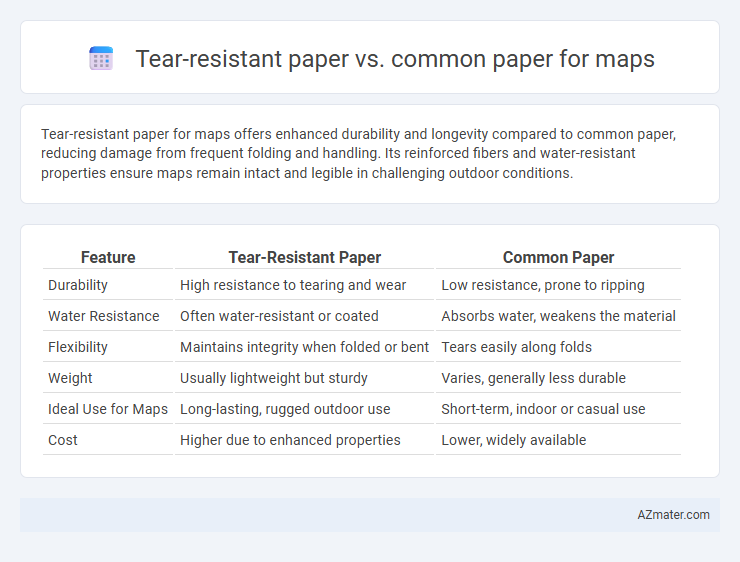Tear-resistant paper for maps offers enhanced durability and longevity compared to common paper, reducing damage from frequent folding and handling. Its reinforced fibers and water-resistant properties ensure maps remain intact and legible in challenging outdoor conditions.
Table of Comparison
| Feature | Tear-Resistant Paper | Common Paper |
|---|---|---|
| Durability | High resistance to tearing and wear | Low resistance, prone to ripping |
| Water Resistance | Often water-resistant or coated | Absorbs water, weakens the material |
| Flexibility | Maintains integrity when folded or bent | Tears easily along folds |
| Weight | Usually lightweight but sturdy | Varies, generally less durable |
| Ideal Use for Maps | Long-lasting, rugged outdoor use | Short-term, indoor or casual use |
| Cost | Higher due to enhanced properties | Lower, widely available |
Introduction to Map Paper Types
Tear-resistant paper offers superior durability and water resistance compared to common paper, making it ideal for frequent handling and outdoor use in maps. Common paper, typically made from standard wood pulp, is more prone to tearing, moisture damage, and wear, limiting its lifespan and usability in rugged environments. Selecting tear-resistant paper enhances map longevity and reliability, ensuring clarity and strength during navigation or fieldwork.
What is Tear-Resistant Paper?
Tear-resistant paper is specially engineered with synthetic fibers or resin coatings to enhance durability and prevent rips, making it ideal for maps exposed to rough handling or outdoor conditions. Unlike common paper, which easily tears after frequent folding or moisture exposure, tear-resistant paper maintains its structural integrity, ensuring longevity and readability in diverse environments. This advanced strength is crucial for maps used in hiking, navigation, and fieldwork where durability directly impacts usability.
Common Paper: Features and Limitations
Common paper used for maps is typically thinner and less durable, making it prone to tearing, creasing, and water damage during regular use. Its lightweight nature offers cost-effectiveness and ease of printing but compromises longevity and resistance to outdoor conditions. These limitations necessitate careful handling and frequent replacement compared to tear-resistant paper, which provides enhanced durability and weather resistance for more demanding applications.
Durability: Tear-Resistant vs Common Paper
Tear-resistant paper offers superior durability for maps, with high tensile strength and resistance to rips compared to common paper. Common paper is prone to easy tearing and wear, especially under frequent handling or outdoor conditions. Maps printed on tear-resistant paper maintain integrity and readability over extended use, making them ideal for rugged, outdoor applications.
Water and Weather Resistance
Tear-resistant paper for maps offers superior durability against water and varying weather conditions compared to common paper, which tends to absorb moisture and weaken quickly. This specialized paper often incorporates synthetic fibers or coatings that repel water, preventing smudging and damage caused by rain or humidity. Maps printed on tear-resistant paper maintain legibility and structural integrity during outdoor use, making them ideal for hiking, camping, and navigation in harsh environments.
Print Quality and Readability
Tear-resistant paper offers superior print quality for maps, maintaining sharp, vivid colors and fine details even under frequent handling. Its durable surface prevents smudging and ink bleeding, ensuring consistent readability in various environmental conditions. Common paper, by contrast, often leads to faded prints and blurred text over time, compromising the map's clarity and usability.
Cost Comparison
Tear-resistant paper typically costs 30% to 50% more than common paper due to its specialized fiber composition and durability-enhancing coatings, making it a higher upfront investment for map production. While common paper is inexpensive and widely available, it often requires more frequent replacement due to wear and damage, which can increase long-term expenses. For high-use maps, tear-resistant paper reduces maintenance and replacement costs, offering better value despite the initial price difference.
Environmental Impact
Tear-resistant paper for maps significantly reduces environmental impact by minimizing waste and extending product lifespan, leading to fewer replacements compared to common paper. Its durable fibers often include recycled materials and require less frequent printing, decreasing deforestation and energy consumption. Common paper maps generate more landfill material due to their fragility and shorter usability, increasing environmental pollution and resource depletion.
Ideal Uses for Each Paper Type
Tear-resistant paper is ideal for outdoor maps used in rugged environments such as hiking, camping, and fieldwork, offering durability against moisture, tears, and rough handling. Common paper is suitable for indoor or light-use maps, including classroom atlases, office presentations, and casual reference where cost-effectiveness and print clarity are priorities. Selecting tear-resistant paper enhances longevity and usability in demanding conditions, whereas common paper meets everyday mapping needs with high-quality print results.
Choosing the Best Paper for Maps
Tear-resistant paper offers superior durability compared to common paper, making it ideal for maps frequently used in rugged environments or outdoor activities. This specialized paper often incorporates synthetic fibers or coatings that enhance resistance to water, tearing, and general wear, ensuring maps remain intact during handling under harsh conditions. Choosing tear-resistant paper for maps increases longevity and reliability, especially for hikers, emergency responders, and field professionals who require dependable navigation tools.

Infographic: Tear-resistant paper vs Common paper for Map
 azmater.com
azmater.com